Business Management with Foundation: BMP3002 Types of Companies Report
VerifiedAdded on 2022/11/29
|11
|2561
|341
Report
AI Summary
This report, prepared for a BSc (Hons) Business Management course, delves into the diverse landscape of company types and forms, analyzing their characteristics and functions. It examines various company structures, ranging from micro-businesses to large corporations, and explores the differences between sole traders, partnerships, private limited companies, public limited companies, and cooperative companies. The report further investigates how organizational structures impact business productivity, including functional, divisional, and matrix structures. Additionally, it discusses the influence of macro-environmental factors on businesses, utilizing the PESTEL analysis to evaluate political, economic, social, technological, environmental, and legal considerations. The report concludes by highlighting the interconnectedness of these elements in shaping business operations and success.
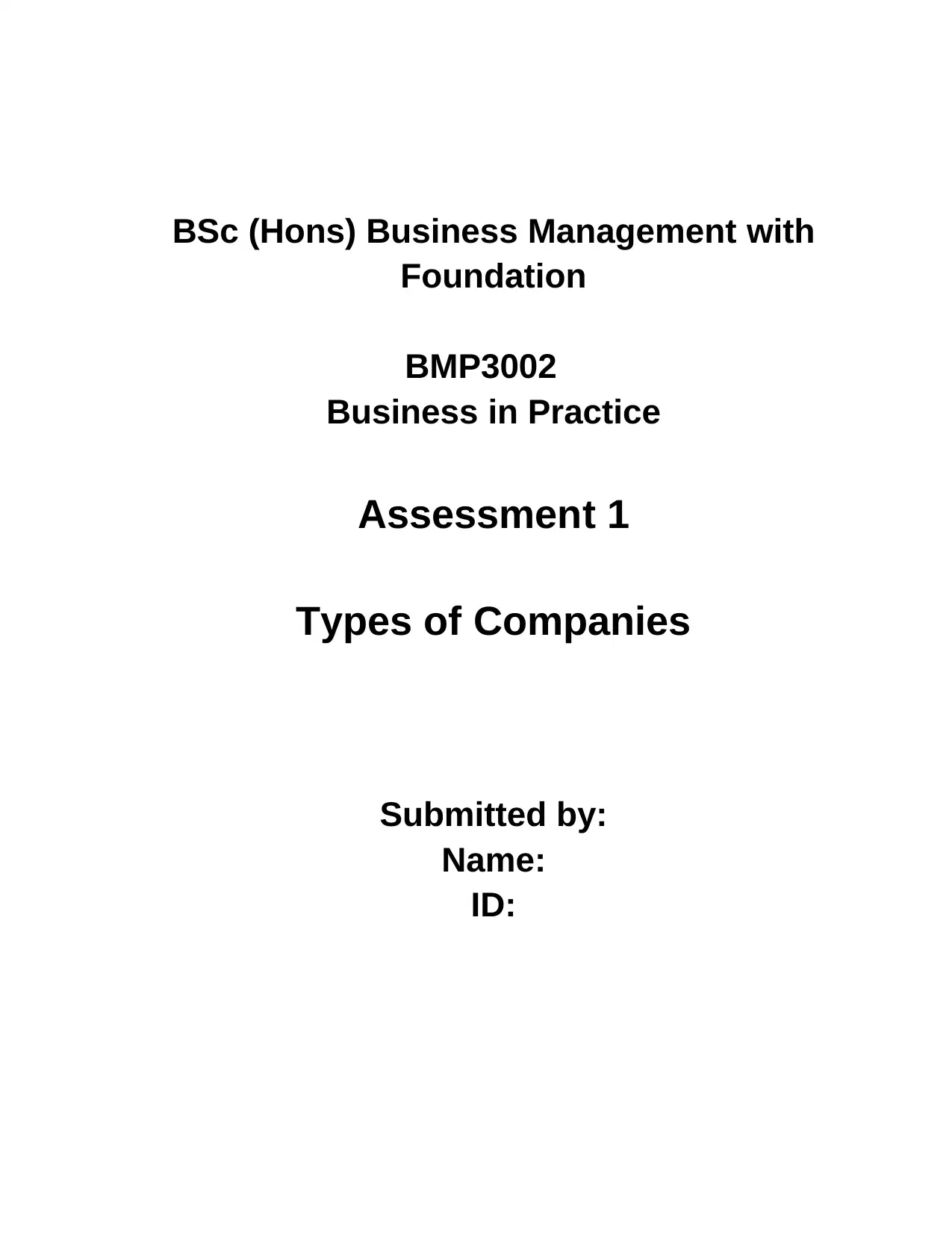
BSc (Hons) Business Management with
Foundation
BMP3002
Business in Practice
Assessment 1
Types of Companies
Submitted by:
Name:
ID:
Foundation
BMP3002
Business in Practice
Assessment 1
Types of Companies
Submitted by:
Name:
ID:
Paraphrase This Document
Need a fresh take? Get an instant paraphrase of this document with our AI Paraphraser
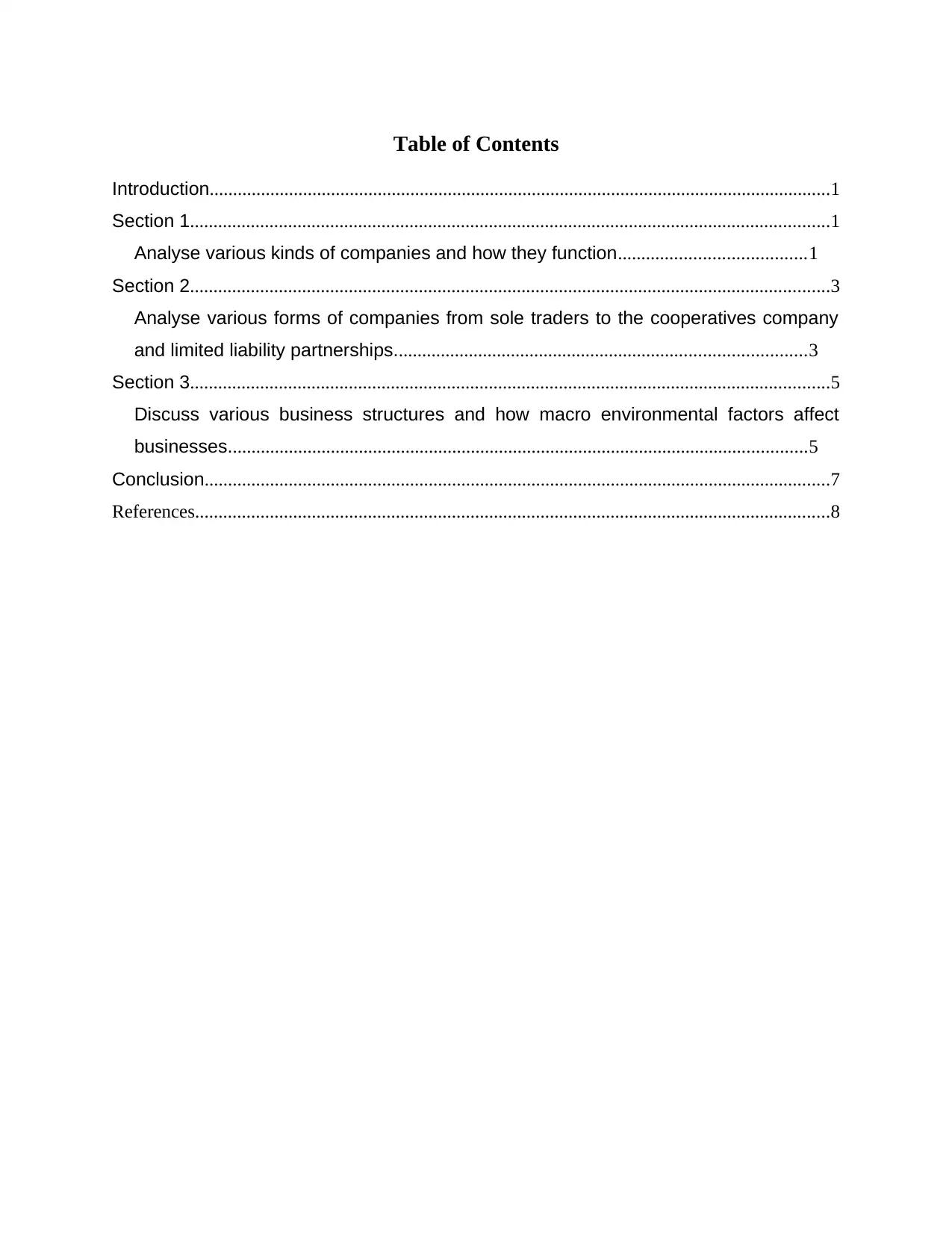
Table of Contents
Introduction.....................................................................................................................................1
Section 1.........................................................................................................................................1
Analyse various kinds of companies and how they function........................................1
Section 2.........................................................................................................................................3
Analyse various forms of companies from sole traders to the cooperatives company
and limited liability partnerships........................................................................................3
Section 3.........................................................................................................................................5
Discuss various business structures and how macro environmental factors affect
businesses............................................................................................................................5
Conclusion......................................................................................................................................7
References........................................................................................................................................8
Introduction.....................................................................................................................................1
Section 1.........................................................................................................................................1
Analyse various kinds of companies and how they function........................................1
Section 2.........................................................................................................................................3
Analyse various forms of companies from sole traders to the cooperatives company
and limited liability partnerships........................................................................................3
Section 3.........................................................................................................................................5
Discuss various business structures and how macro environmental factors affect
businesses............................................................................................................................5
Conclusion......................................................................................................................................7
References........................................................................................................................................8
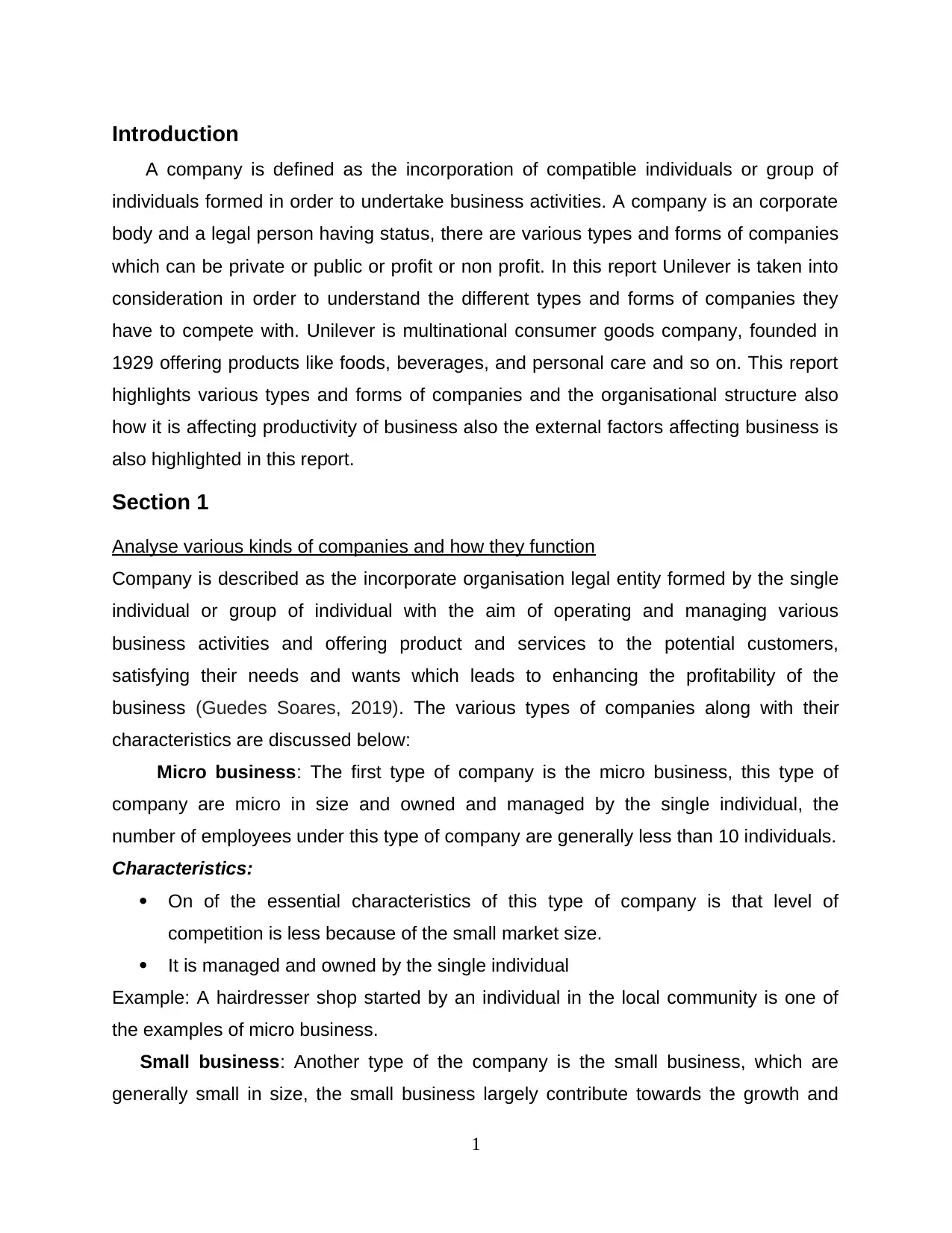
Introduction
A company is defined as the incorporation of compatible individuals or group of
individuals formed in order to undertake business activities. A company is an corporate
body and a legal person having status, there are various types and forms of companies
which can be private or public or profit or non profit. In this report Unilever is taken into
consideration in order to understand the different types and forms of companies they
have to compete with. Unilever is multinational consumer goods company, founded in
1929 offering products like foods, beverages, and personal care and so on. This report
highlights various types and forms of companies and the organisational structure also
how it is affecting productivity of business also the external factors affecting business is
also highlighted in this report.
Section 1
Analyse various kinds of companies and how they function
Company is described as the incorporate organisation legal entity formed by the single
individual or group of individual with the aim of operating and managing various
business activities and offering product and services to the potential customers,
satisfying their needs and wants which leads to enhancing the profitability of the
business (Guedes Soares, 2019). The various types of companies along with their
characteristics are discussed below:
Micro business: The first type of company is the micro business, this type of
company are micro in size and owned and managed by the single individual, the
number of employees under this type of company are generally less than 10 individuals.
Characteristics:
On of the essential characteristics of this type of company is that level of
competition is less because of the small market size.
It is managed and owned by the single individual
Example: A hairdresser shop started by an individual in the local community is one of
the examples of micro business.
Small business: Another type of the company is the small business, which are
generally small in size, the small business largely contribute towards the growth and
1
A company is defined as the incorporation of compatible individuals or group of
individuals formed in order to undertake business activities. A company is an corporate
body and a legal person having status, there are various types and forms of companies
which can be private or public or profit or non profit. In this report Unilever is taken into
consideration in order to understand the different types and forms of companies they
have to compete with. Unilever is multinational consumer goods company, founded in
1929 offering products like foods, beverages, and personal care and so on. This report
highlights various types and forms of companies and the organisational structure also
how it is affecting productivity of business also the external factors affecting business is
also highlighted in this report.
Section 1
Analyse various kinds of companies and how they function
Company is described as the incorporate organisation legal entity formed by the single
individual or group of individual with the aim of operating and managing various
business activities and offering product and services to the potential customers,
satisfying their needs and wants which leads to enhancing the profitability of the
business (Guedes Soares, 2019). The various types of companies along with their
characteristics are discussed below:
Micro business: The first type of company is the micro business, this type of
company are micro in size and owned and managed by the single individual, the
number of employees under this type of company are generally less than 10 individuals.
Characteristics:
On of the essential characteristics of this type of company is that level of
competition is less because of the small market size.
It is managed and owned by the single individual
Example: A hairdresser shop started by an individual in the local community is one of
the examples of micro business.
Small business: Another type of the company is the small business, which are
generally small in size, the small business largely contribute towards the growth and
1
You're viewing a preview
Unlock full access by subscribing today!
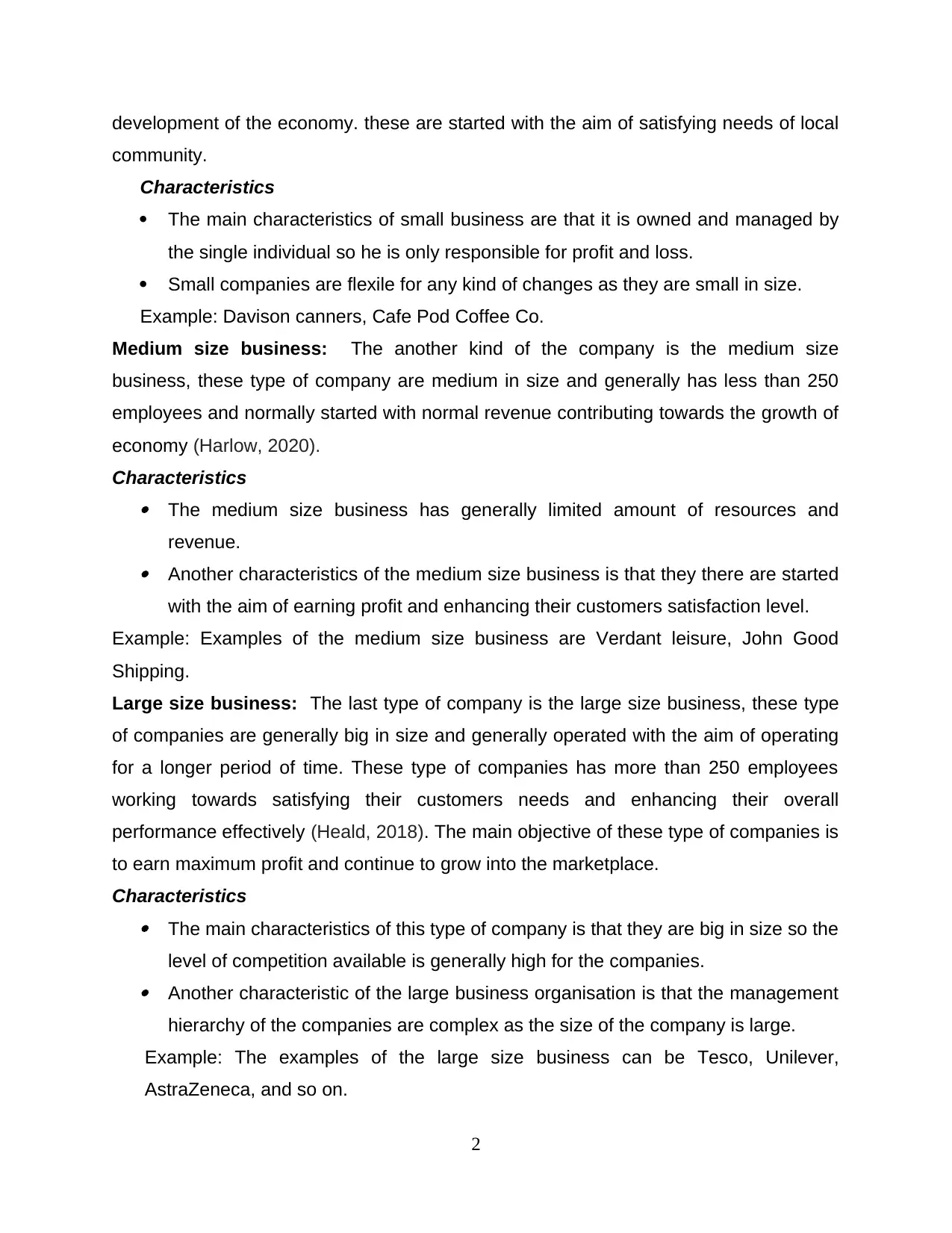
development of the economy. these are started with the aim of satisfying needs of local
community.
Characteristics
The main characteristics of small business are that it is owned and managed by
the single individual so he is only responsible for profit and loss.
Small companies are flexile for any kind of changes as they are small in size.
Example: Davison canners, Cafe Pod Coffee Co.
Medium size business: The another kind of the company is the medium size
business, these type of company are medium in size and generally has less than 250
employees and normally started with normal revenue contributing towards the growth of
economy (Harlow, 2020).
Characteristics The medium size business has generally limited amount of resources and
revenue. Another characteristics of the medium size business is that they there are started
with the aim of earning profit and enhancing their customers satisfaction level.
Example: Examples of the medium size business are Verdant leisure, John Good
Shipping.
Large size business: The last type of company is the large size business, these type
of companies are generally big in size and generally operated with the aim of operating
for a longer period of time. These type of companies has more than 250 employees
working towards satisfying their customers needs and enhancing their overall
performance effectively (Heald, 2018). The main objective of these type of companies is
to earn maximum profit and continue to grow into the marketplace.
Characteristics The main characteristics of this type of company is that they are big in size so the
level of competition available is generally high for the companies. Another characteristic of the large business organisation is that the management
hierarchy of the companies are complex as the size of the company is large.
Example: The examples of the large size business can be Tesco, Unilever,
AstraZeneca, and so on.
2
community.
Characteristics
The main characteristics of small business are that it is owned and managed by
the single individual so he is only responsible for profit and loss.
Small companies are flexile for any kind of changes as they are small in size.
Example: Davison canners, Cafe Pod Coffee Co.
Medium size business: The another kind of the company is the medium size
business, these type of company are medium in size and generally has less than 250
employees and normally started with normal revenue contributing towards the growth of
economy (Harlow, 2020).
Characteristics The medium size business has generally limited amount of resources and
revenue. Another characteristics of the medium size business is that they there are started
with the aim of earning profit and enhancing their customers satisfaction level.
Example: Examples of the medium size business are Verdant leisure, John Good
Shipping.
Large size business: The last type of company is the large size business, these type
of companies are generally big in size and generally operated with the aim of operating
for a longer period of time. These type of companies has more than 250 employees
working towards satisfying their customers needs and enhancing their overall
performance effectively (Heald, 2018). The main objective of these type of companies is
to earn maximum profit and continue to grow into the marketplace.
Characteristics The main characteristics of this type of company is that they are big in size so the
level of competition available is generally high for the companies. Another characteristic of the large business organisation is that the management
hierarchy of the companies are complex as the size of the company is large.
Example: The examples of the large size business can be Tesco, Unilever,
AstraZeneca, and so on.
2
Paraphrase This Document
Need a fresh take? Get an instant paraphrase of this document with our AI Paraphraser
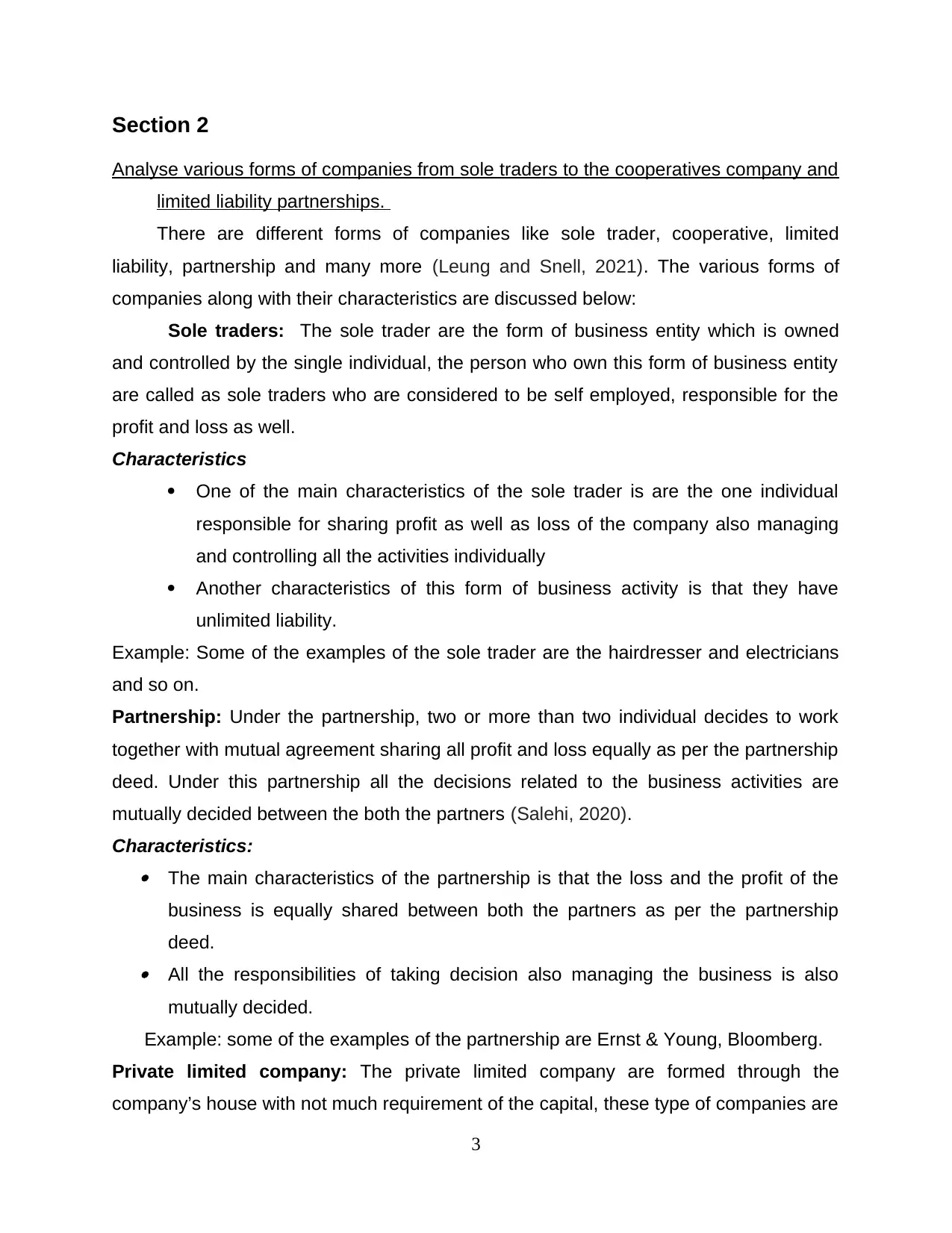
Section 2
Analyse various forms of companies from sole traders to the cooperatives company and
limited liability partnerships.
There are different forms of companies like sole trader, cooperative, limited
liability, partnership and many more (Leung and Snell, 2021). The various forms of
companies along with their characteristics are discussed below:
Sole traders: The sole trader are the form of business entity which is owned
and controlled by the single individual, the person who own this form of business entity
are called as sole traders who are considered to be self employed, responsible for the
profit and loss as well.
Characteristics
One of the main characteristics of the sole trader is are the one individual
responsible for sharing profit as well as loss of the company also managing
and controlling all the activities individually
Another characteristics of this form of business activity is that they have
unlimited liability.
Example: Some of the examples of the sole trader are the hairdresser and electricians
and so on.
Partnership: Under the partnership, two or more than two individual decides to work
together with mutual agreement sharing all profit and loss equally as per the partnership
deed. Under this partnership all the decisions related to the business activities are
mutually decided between the both the partners (Salehi, 2020).
Characteristics: The main characteristics of the partnership is that the loss and the profit of the
business is equally shared between both the partners as per the partnership
deed. All the responsibilities of taking decision also managing the business is also
mutually decided.
Example: some of the examples of the partnership are Ernst & Young, Bloomberg.
Private limited company: The private limited company are formed through the
company’s house with not much requirement of the capital, these type of companies are
3
Analyse various forms of companies from sole traders to the cooperatives company and
limited liability partnerships.
There are different forms of companies like sole trader, cooperative, limited
liability, partnership and many more (Leung and Snell, 2021). The various forms of
companies along with their characteristics are discussed below:
Sole traders: The sole trader are the form of business entity which is owned
and controlled by the single individual, the person who own this form of business entity
are called as sole traders who are considered to be self employed, responsible for the
profit and loss as well.
Characteristics
One of the main characteristics of the sole trader is are the one individual
responsible for sharing profit as well as loss of the company also managing
and controlling all the activities individually
Another characteristics of this form of business activity is that they have
unlimited liability.
Example: Some of the examples of the sole trader are the hairdresser and electricians
and so on.
Partnership: Under the partnership, two or more than two individual decides to work
together with mutual agreement sharing all profit and loss equally as per the partnership
deed. Under this partnership all the decisions related to the business activities are
mutually decided between the both the partners (Salehi, 2020).
Characteristics: The main characteristics of the partnership is that the loss and the profit of the
business is equally shared between both the partners as per the partnership
deed. All the responsibilities of taking decision also managing the business is also
mutually decided.
Example: some of the examples of the partnership are Ernst & Young, Bloomberg.
Private limited company: The private limited company are formed through the
company’s house with not much requirement of the capital, these type of companies are
3
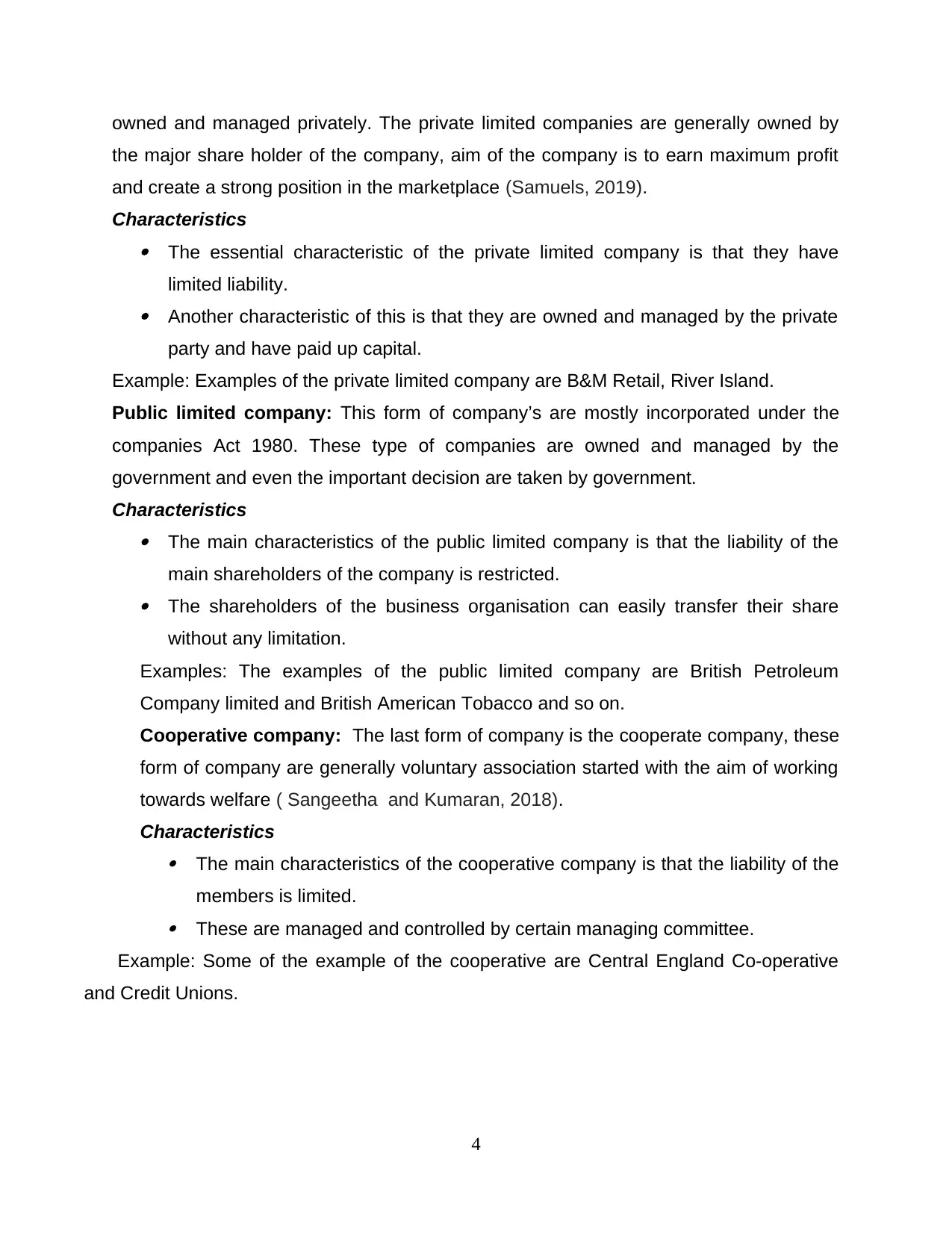
owned and managed privately. The private limited companies are generally owned by
the major share holder of the company, aim of the company is to earn maximum profit
and create a strong position in the marketplace (Samuels, 2019).
Characteristics The essential characteristic of the private limited company is that they have
limited liability. Another characteristic of this is that they are owned and managed by the private
party and have paid up capital.
Example: Examples of the private limited company are B&M Retail, River Island.
Public limited company: This form of company’s are mostly incorporated under the
companies Act 1980. These type of companies are owned and managed by the
government and even the important decision are taken by government.
Characteristics The main characteristics of the public limited company is that the liability of the
main shareholders of the company is restricted. The shareholders of the business organisation can easily transfer their share
without any limitation.
Examples: The examples of the public limited company are British Petroleum
Company limited and British American Tobacco and so on.
Cooperative company: The last form of company is the cooperate company, these
form of company are generally voluntary association started with the aim of working
towards welfare ( Sangeetha and Kumaran, 2018).
Characteristics
The main characteristics of the cooperative company is that the liability of the
members is limited.
These are managed and controlled by certain managing committee.
Example: Some of the example of the cooperative are Central England Co-operative
and Credit Unions.
4
the major share holder of the company, aim of the company is to earn maximum profit
and create a strong position in the marketplace (Samuels, 2019).
Characteristics The essential characteristic of the private limited company is that they have
limited liability. Another characteristic of this is that they are owned and managed by the private
party and have paid up capital.
Example: Examples of the private limited company are B&M Retail, River Island.
Public limited company: This form of company’s are mostly incorporated under the
companies Act 1980. These type of companies are owned and managed by the
government and even the important decision are taken by government.
Characteristics The main characteristics of the public limited company is that the liability of the
main shareholders of the company is restricted. The shareholders of the business organisation can easily transfer their share
without any limitation.
Examples: The examples of the public limited company are British Petroleum
Company limited and British American Tobacco and so on.
Cooperative company: The last form of company is the cooperate company, these
form of company are generally voluntary association started with the aim of working
towards welfare ( Sangeetha and Kumaran, 2018).
Characteristics
The main characteristics of the cooperative company is that the liability of the
members is limited.
These are managed and controlled by certain managing committee.
Example: Some of the example of the cooperative are Central England Co-operative
and Credit Unions.
4
You're viewing a preview
Unlock full access by subscribing today!
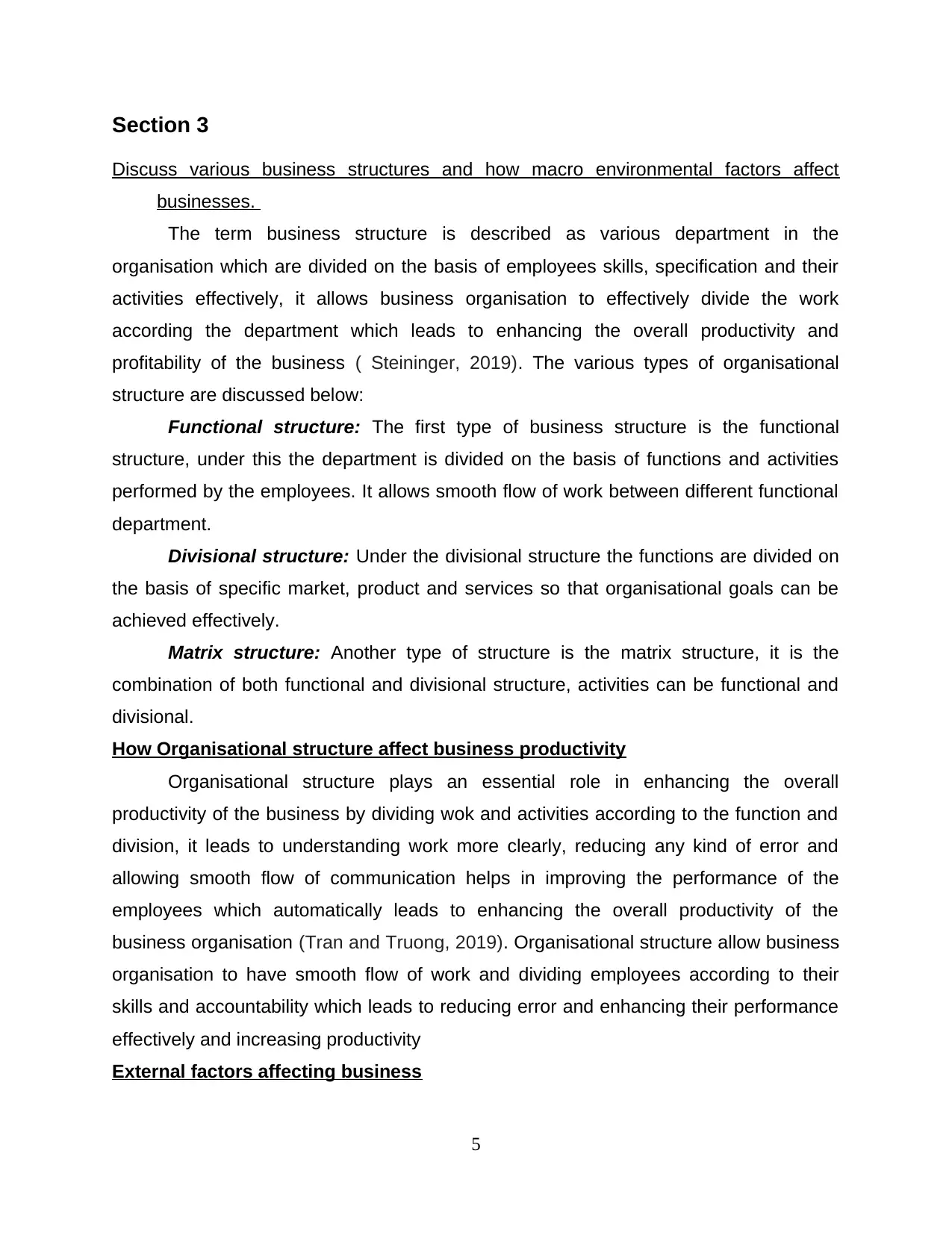
Section 3
Discuss various business structures and how macro environmental factors affect
businesses.
The term business structure is described as various department in the
organisation which are divided on the basis of employees skills, specification and their
activities effectively, it allows business organisation to effectively divide the work
according the department which leads to enhancing the overall productivity and
profitability of the business ( Steininger, 2019). The various types of organisational
structure are discussed below:
Functional structure: The first type of business structure is the functional
structure, under this the department is divided on the basis of functions and activities
performed by the employees. It allows smooth flow of work between different functional
department.
Divisional structure: Under the divisional structure the functions are divided on
the basis of specific market, product and services so that organisational goals can be
achieved effectively.
Matrix structure: Another type of structure is the matrix structure, it is the
combination of both functional and divisional structure, activities can be functional and
divisional.
How Organisational structure affect business productivity
Organisational structure plays an essential role in enhancing the overall
productivity of the business by dividing wok and activities according to the function and
division, it leads to understanding work more clearly, reducing any kind of error and
allowing smooth flow of communication helps in improving the performance of the
employees which automatically leads to enhancing the overall productivity of the
business organisation (Tran and Truong, 2019). Organisational structure allow business
organisation to have smooth flow of work and dividing employees according to their
skills and accountability which leads to reducing error and enhancing their performance
effectively and increasing productivity
External factors affecting business
5
Discuss various business structures and how macro environmental factors affect
businesses.
The term business structure is described as various department in the
organisation which are divided on the basis of employees skills, specification and their
activities effectively, it allows business organisation to effectively divide the work
according the department which leads to enhancing the overall productivity and
profitability of the business ( Steininger, 2019). The various types of organisational
structure are discussed below:
Functional structure: The first type of business structure is the functional
structure, under this the department is divided on the basis of functions and activities
performed by the employees. It allows smooth flow of work between different functional
department.
Divisional structure: Under the divisional structure the functions are divided on
the basis of specific market, product and services so that organisational goals can be
achieved effectively.
Matrix structure: Another type of structure is the matrix structure, it is the
combination of both functional and divisional structure, activities can be functional and
divisional.
How Organisational structure affect business productivity
Organisational structure plays an essential role in enhancing the overall
productivity of the business by dividing wok and activities according to the function and
division, it leads to understanding work more clearly, reducing any kind of error and
allowing smooth flow of communication helps in improving the performance of the
employees which automatically leads to enhancing the overall productivity of the
business organisation (Tran and Truong, 2019). Organisational structure allow business
organisation to have smooth flow of work and dividing employees according to their
skills and accountability which leads to reducing error and enhancing their performance
effectively and increasing productivity
External factors affecting business
5
Paraphrase This Document
Need a fresh take? Get an instant paraphrase of this document with our AI Paraphraser
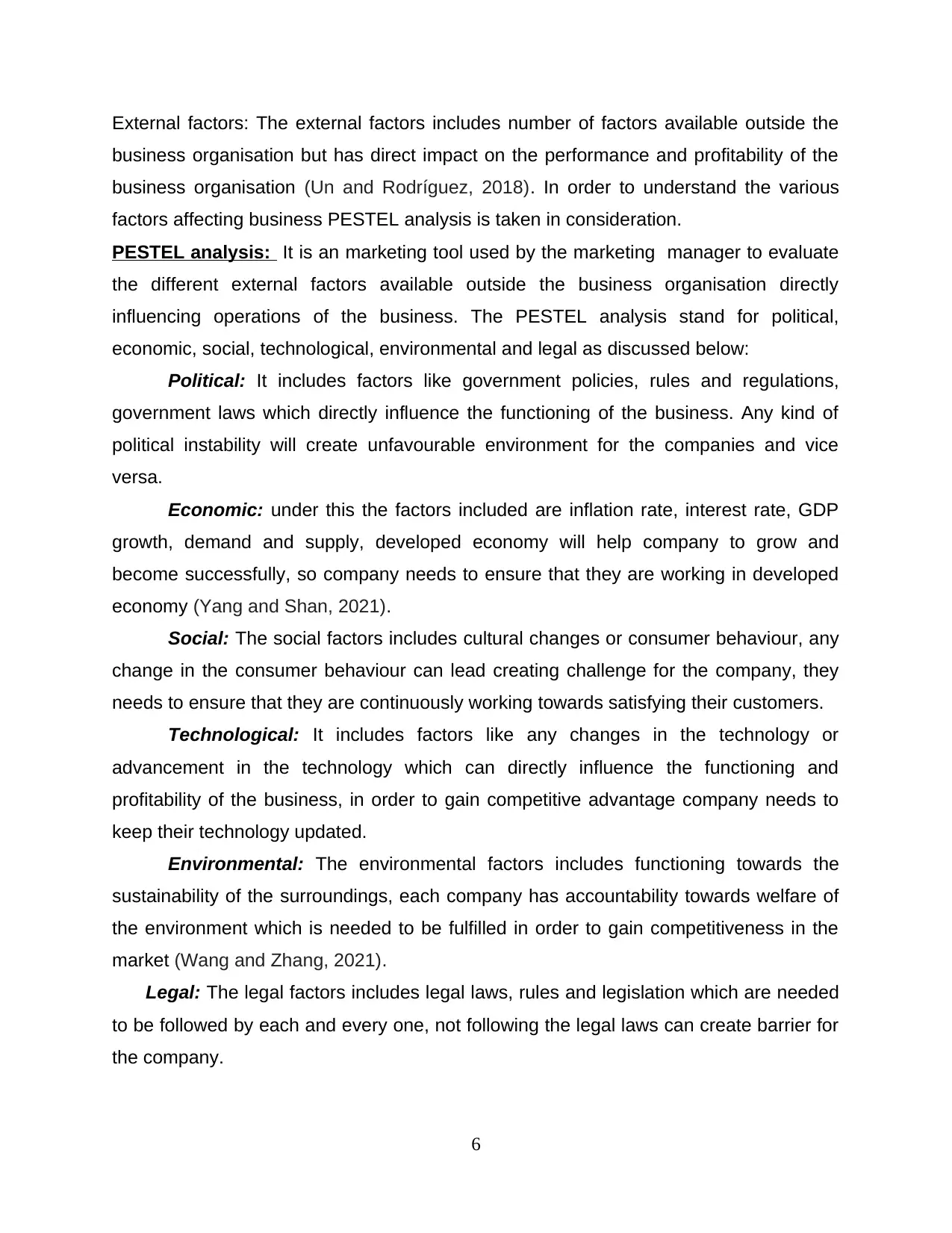
External factors: The external factors includes number of factors available outside the
business organisation but has direct impact on the performance and profitability of the
business organisation (Un and Rodríguez, 2018). In order to understand the various
factors affecting business PESTEL analysis is taken in consideration.
PESTEL analysis: It is an marketing tool used by the marketing manager to evaluate
the different external factors available outside the business organisation directly
influencing operations of the business. The PESTEL analysis stand for political,
economic, social, technological, environmental and legal as discussed below:
Political: It includes factors like government policies, rules and regulations,
government laws which directly influence the functioning of the business. Any kind of
political instability will create unfavourable environment for the companies and vice
versa.
Economic: under this the factors included are inflation rate, interest rate, GDP
growth, demand and supply, developed economy will help company to grow and
become successfully, so company needs to ensure that they are working in developed
economy (Yang and Shan, 2021).
Social: The social factors includes cultural changes or consumer behaviour, any
change in the consumer behaviour can lead creating challenge for the company, they
needs to ensure that they are continuously working towards satisfying their customers.
Technological: It includes factors like any changes in the technology or
advancement in the technology which can directly influence the functioning and
profitability of the business, in order to gain competitive advantage company needs to
keep their technology updated.
Environmental: The environmental factors includes functioning towards the
sustainability of the surroundings, each company has accountability towards welfare of
the environment which is needed to be fulfilled in order to gain competitiveness in the
market (Wang and Zhang, 2021).
Legal: The legal factors includes legal laws, rules and legislation which are needed
to be followed by each and every one, not following the legal laws can create barrier for
the company.
6
business organisation but has direct impact on the performance and profitability of the
business organisation (Un and Rodríguez, 2018). In order to understand the various
factors affecting business PESTEL analysis is taken in consideration.
PESTEL analysis: It is an marketing tool used by the marketing manager to evaluate
the different external factors available outside the business organisation directly
influencing operations of the business. The PESTEL analysis stand for political,
economic, social, technological, environmental and legal as discussed below:
Political: It includes factors like government policies, rules and regulations,
government laws which directly influence the functioning of the business. Any kind of
political instability will create unfavourable environment for the companies and vice
versa.
Economic: under this the factors included are inflation rate, interest rate, GDP
growth, demand and supply, developed economy will help company to grow and
become successfully, so company needs to ensure that they are working in developed
economy (Yang and Shan, 2021).
Social: The social factors includes cultural changes or consumer behaviour, any
change in the consumer behaviour can lead creating challenge for the company, they
needs to ensure that they are continuously working towards satisfying their customers.
Technological: It includes factors like any changes in the technology or
advancement in the technology which can directly influence the functioning and
profitability of the business, in order to gain competitive advantage company needs to
keep their technology updated.
Environmental: The environmental factors includes functioning towards the
sustainability of the surroundings, each company has accountability towards welfare of
the environment which is needed to be fulfilled in order to gain competitiveness in the
market (Wang and Zhang, 2021).
Legal: The legal factors includes legal laws, rules and legislation which are needed
to be followed by each and every one, not following the legal laws can create barrier for
the company.
6
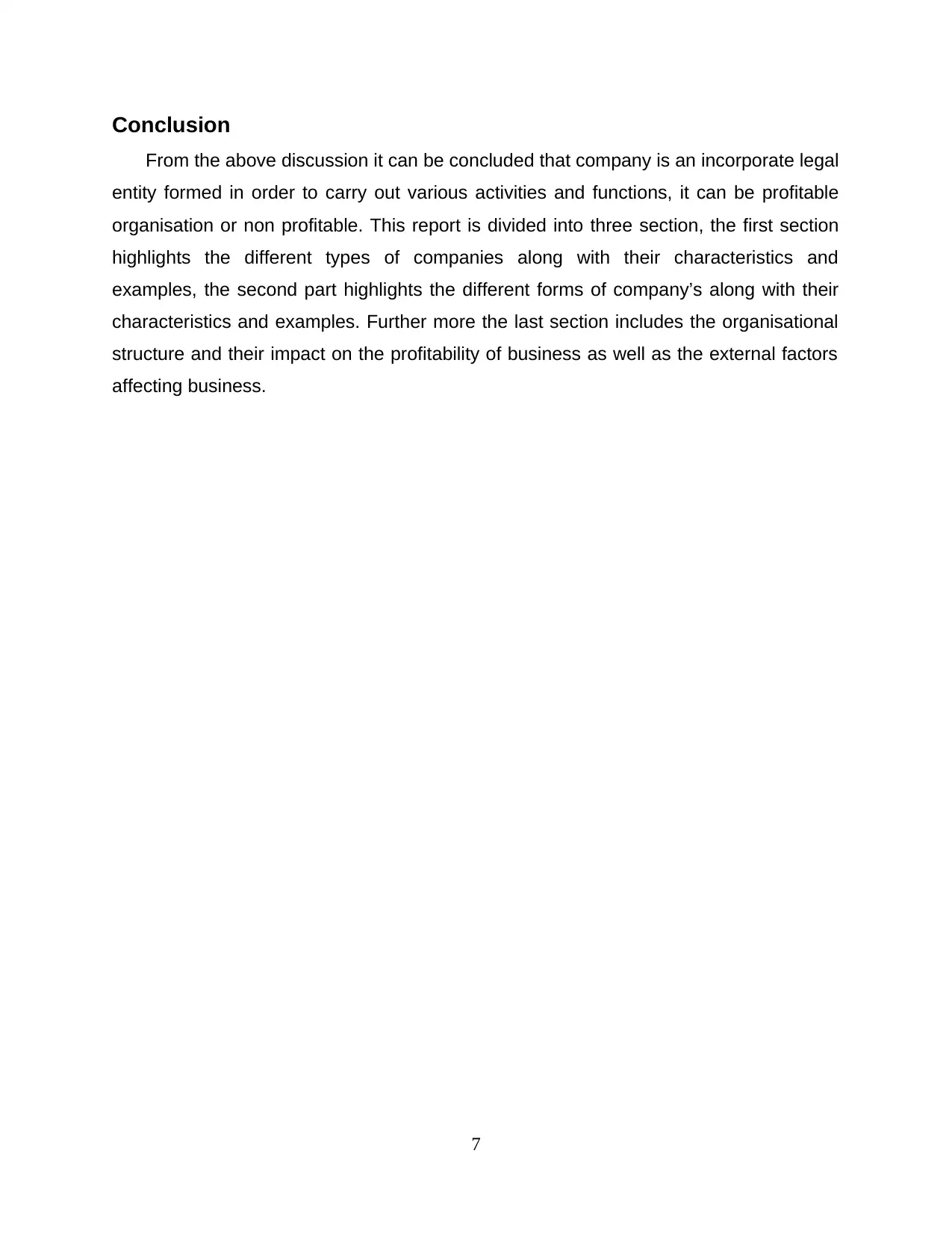
Conclusion
From the above discussion it can be concluded that company is an incorporate legal
entity formed in order to carry out various activities and functions, it can be profitable
organisation or non profitable. This report is divided into three section, the first section
highlights the different types of companies along with their characteristics and
examples, the second part highlights the different forms of company’s along with their
characteristics and examples. Further more the last section includes the organisational
structure and their impact on the profitability of business as well as the external factors
affecting business.
7
From the above discussion it can be concluded that company is an incorporate legal
entity formed in order to carry out various activities and functions, it can be profitable
organisation or non profitable. This report is divided into three section, the first section
highlights the different types of companies along with their characteristics and
examples, the second part highlights the different forms of company’s along with their
characteristics and examples. Further more the last section includes the organisational
structure and their impact on the profitability of business as well as the external factors
affecting business.
7
You're viewing a preview
Unlock full access by subscribing today!
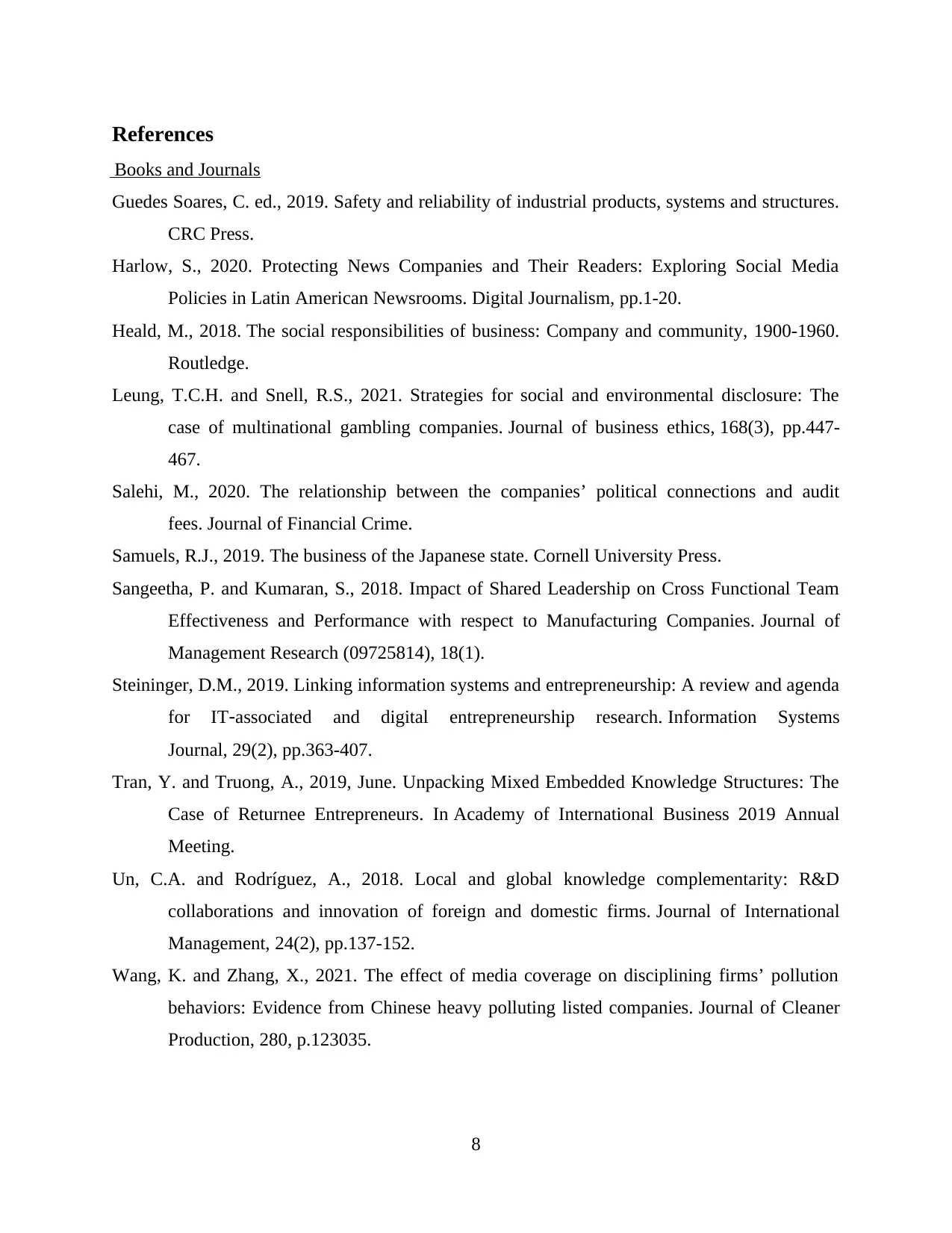
References
Books and Journals
Guedes Soares, C. ed., 2019. Safety and reliability of industrial products, systems and structures.
CRC Press.
Harlow, S., 2020. Protecting News Companies and Their Readers: Exploring Social Media
Policies in Latin American Newsrooms. Digital Journalism, pp.1-20.
Heald, M., 2018. The social responsibilities of business: Company and community, 1900-1960.
Routledge.
Leung, T.C.H. and Snell, R.S., 2021. Strategies for social and environmental disclosure: The
case of multinational gambling companies. Journal of business ethics, 168(3), pp.447-
467.
Salehi, M., 2020. The relationship between the companies’ political connections and audit
fees. Journal of Financial Crime.
Samuels, R.J., 2019. The business of the Japanese state. Cornell University Press.
Sangeetha, P. and Kumaran, S., 2018. Impact of Shared Leadership on Cross Functional Team
Effectiveness and Performance with respect to Manufacturing Companies. Journal of
Management Research (09725814), 18(1).
Steininger, D.M., 2019. Linking information systems and entrepreneurship: A review and agenda
for IT‐associated and digital entrepreneurship research. Information Systems
Journal, 29(2), pp.363-407.
Tran, Y. and Truong, A., 2019, June. Unpacking Mixed Embedded Knowledge Structures: The
Case of Returnee Entrepreneurs. In Academy of International Business 2019 Annual
Meeting.
Un, C.A. and Rodríguez, A., 2018. Local and global knowledge complementarity: R&D
collaborations and innovation of foreign and domestic firms. Journal of International
Management, 24(2), pp.137-152.
Wang, K. and Zhang, X., 2021. The effect of media coverage on disciplining firms’ pollution
behaviors: Evidence from Chinese heavy polluting listed companies. Journal of Cleaner
Production, 280, p.123035.
8
Books and Journals
Guedes Soares, C. ed., 2019. Safety and reliability of industrial products, systems and structures.
CRC Press.
Harlow, S., 2020. Protecting News Companies and Their Readers: Exploring Social Media
Policies in Latin American Newsrooms. Digital Journalism, pp.1-20.
Heald, M., 2018. The social responsibilities of business: Company and community, 1900-1960.
Routledge.
Leung, T.C.H. and Snell, R.S., 2021. Strategies for social and environmental disclosure: The
case of multinational gambling companies. Journal of business ethics, 168(3), pp.447-
467.
Salehi, M., 2020. The relationship between the companies’ political connections and audit
fees. Journal of Financial Crime.
Samuels, R.J., 2019. The business of the Japanese state. Cornell University Press.
Sangeetha, P. and Kumaran, S., 2018. Impact of Shared Leadership on Cross Functional Team
Effectiveness and Performance with respect to Manufacturing Companies. Journal of
Management Research (09725814), 18(1).
Steininger, D.M., 2019. Linking information systems and entrepreneurship: A review and agenda
for IT‐associated and digital entrepreneurship research. Information Systems
Journal, 29(2), pp.363-407.
Tran, Y. and Truong, A., 2019, June. Unpacking Mixed Embedded Knowledge Structures: The
Case of Returnee Entrepreneurs. In Academy of International Business 2019 Annual
Meeting.
Un, C.A. and Rodríguez, A., 2018. Local and global knowledge complementarity: R&D
collaborations and innovation of foreign and domestic firms. Journal of International
Management, 24(2), pp.137-152.
Wang, K. and Zhang, X., 2021. The effect of media coverage on disciplining firms’ pollution
behaviors: Evidence from Chinese heavy polluting listed companies. Journal of Cleaner
Production, 280, p.123035.
8
Paraphrase This Document
Need a fresh take? Get an instant paraphrase of this document with our AI Paraphraser
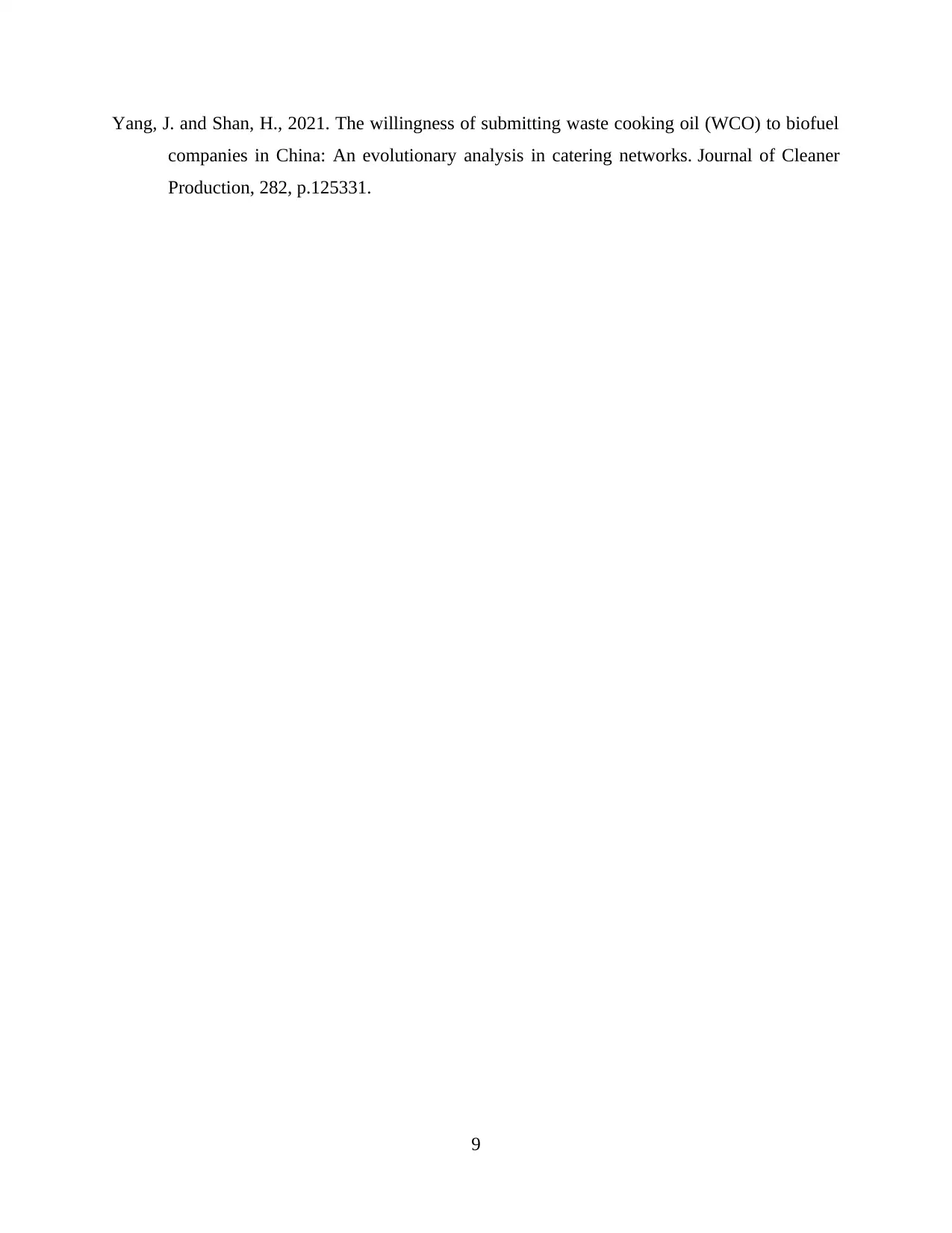
Yang, J. and Shan, H., 2021. The willingness of submitting waste cooking oil (WCO) to biofuel
companies in China: An evolutionary analysis in catering networks. Journal of Cleaner
Production, 282, p.125331.
9
companies in China: An evolutionary analysis in catering networks. Journal of Cleaner
Production, 282, p.125331.
9
1 out of 11
Related Documents
Your All-in-One AI-Powered Toolkit for Academic Success.
+13062052269
info@desklib.com
Available 24*7 on WhatsApp / Email
![[object Object]](/_next/static/media/star-bottom.7253800d.svg)
Unlock your academic potential
© 2024 | Zucol Services PVT LTD | All rights reserved.




